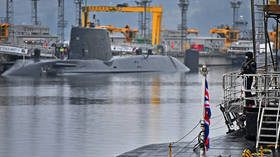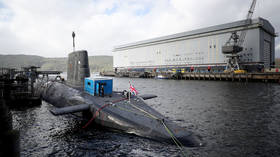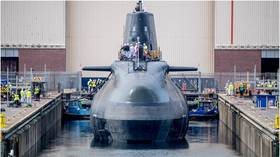UK doubles down on nuclear plans

Britain intends to build entirely new warheads for the Trident ballistic missiles, to be carried by the upcoming Dreadnought-class atomic submarines, the Defence Ministry has revealed. The domestic development and production will cost an additional of £9 billion ($11.6 billion) over the next five years.
The ministry’s report, presented to parliament on Tuesday and made public on Wednesday, describes nuclear modernization as a “one-in-two-generations” endeavor that will “support the construction of industrial infrastructure” and the modernization of manufacturing and maintenance capabilities.
The British nuclear arsenal has been entirely submarine-based since 1998, and currently revolves around four Vanguard-class missile boats carrying Trident II missiles. Parliament green-lit the development and construction of the Dreadnought-class in 2016, and the first of the class “remains on track” to enter service “in the early 2030s,” according to the report.
Both the new boats and the new warheads for the Tridents “are being designed and constructed in the UK and represent some of the most advanced systems ever built,” the MoD report claims, and their development is “directly supporting tens of thousands of jobs across the country and investing billions of pounds into the UK economy.”
To make that happen, however, the MoD will spend an additional £3 billion ($3.9 billion) on the nuclear program over the next two years, and another £6 billion ($7.7 billion) over the subsequent three years. This will include improvements to shipyards at Faslane and Devonport.
Other notable earmarks in the defense budget include £2.5 billion ($3.2 billion) over the next 10 years to replenish the depleted stockpiles of ammunition, and £400 million ($516 million) to repair “crumbling” barracks and other accommodations.
Defence Secretary Ben Wallace, who announced his resignation over the weekend, persisted in plans to bolster the Royal Navy while reducing the number of tanks and troops in the ground forces to the smallest size since the Napoleonic wars, according to the Times. Unnamed sources within the military have complained that the new blueprint prioritizes the service formerly led by Admiral Sir Tony Radakin, who took over the general staff in 2021.
London has already picked out the names for the new submarines. Dreadnought’s sister boats will be called Valiant, Warspite and King George VI, according to media reports. While the name ‘Dreadnought’ has a history in the Royal Navy going back to the 1500s, the most famous was the early 20th century battleship based entirely around big guns. Her launch in 1906 triggered a naval arms race with Germany and France. HMS Dreadnought missed all the major battles of the First World War, but entered history books as the only battleship to ever sink a submarine, by ramming a German U-boat in March 1915.














